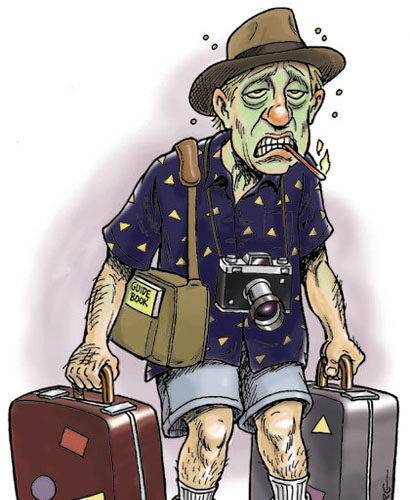🇧🇷 Getting lost (ficar perdido) is the worst! (é a pior coisa ever!). Quanto mais tempo você fica perdido, mais a sua própria respiração começa a te irritar. Graças à avanços tecnológicos, hoje em dia temos o GPS (Global Positioning System) que “comes in handy” (é bem útil) quando “we have no clue” (não temos a mínima ideia) de onde estamos ou para onde vamos. Mas e se você estiver no exterior, sem telefone, e tiver que perdir informações “the old school way” (pelo método tradicional do boca-a-boca)?
Então se você ainda não assistiu ao vídeo “INGLÊS PARA SOBREVIVÊNCIA: COMO PEDIR INFORMAÇÕES EM VIAGENS | Survival English #5,” não perca! E pra você que já assistiu, aqui segue uma “recap” (recapitulação) do vocabulário e das “key sentences” (frases coringa) que a Carina ensina, reacheada de outras dicas e vocabulários.
Basic Vocabulary – Vocabulário Básico
-Hi, can you help me? (Oi, você pode me ajudar?)
-Excuse me, could you help me? (Com licença, você poderia me ajudar?)
-Hi, I’m lost… can you help me? (Oi, eu estou perdido… você poderia me ajudar?)
-Sorry to bother you, but… (Desculpe te incomodar, mas…)
-I’m looking for a good restaurant nearby. Do you have any suggestions? Can you recommend a place? (Eu estou procurando um bom restaurante aqui por perto. Você tem alguma sugestão? Poderia me recomendar algum lugar?
– I’m trying to find the subway station. ( Estou tentando encontrar a estação do metrô.)
-I would like to go to ______. (Eu gostaria de ir à / ao _____.)
Chinatown / the MET Museum / Times Square.
-How do I get to______? (Como eu chego à / ao ______?)
The Statue of Liberty / a subway station / the nearest subway station
-Which subway line should I take to get to the Statue of Liberty?
-If you go that way, you’ll see a map. You can look on-line. (Se você for por ali, você verá uma mapa. Você pode procurar on-line.)
*Cultural Tip: Nova Iorquinos usam o termo “subway” para se referirem ao sistema do metrô, mas para se referirem aos “carros/vagões”, ao trem em si, eles dizem “train” e não “subway.” Ou seja, se você escutar alguém dizendo “subway,” a pessoa provavelmente não é de NYC. Nova Iorquinos também usam o termo “metro” para se referirem ao sistema de trem “Metro-North” que liga o Norte do Estado de Nova Iorque e o estado de Nova Jersey à Manhattan.
*Travel Tip: Quando for a cidade de Nova York por mais de uma semana, compre o Metrocard. Vale muito a pena porque você pode entrar e sair do metrô quantas vezes quiser, sem se preocupar em ficar comprando inúmeros tickets, pagando apenas a flat rate do cartão semanal (cerca de $32), o que “comes in handy” (é muito útil) principalmente se você estiver perdido. Se sua estadia for maior que um mês, compre o cartão mensal! (Observação: Fique atento ao horário dos trens porque de fim de semana e feriado eles mudam).
-Can you help me find______? (Pode me ajudar a encontrar_____?)
The Dream hotel / an ATM (O Hotel “Dream” / um caixa eletrônico)
-Where is Central Park? (Onde é o “Central Park”?)
-Do you know where Central Park is? (Você sabe onde fica o “Central Park”?)
-I’m looking for Central Park. Can you help me? (Estou procurando o “Central Park.” Pode me ajudar?)
-Can you point me in the right direction? (Você pode me apontar pra direção correta?)
-Where am I on this map? (Onde é que estou nesse mapa?)
-Is there a/an______? (Há um/uma____?)
-Is there a post office around here/nearby/ in this area? (Tem algum post office por aqui/ nessa área?)
-Is there an ATM around here? (here – in this mall) (Tem um caixa eletrônico por aqui?)
-Are there any good restaurants around here? (Tem restaurantes bons por aqui?)
-What do you have a taste for? = what kind of food do you want? (Tá afim de comer o quê?)
*Outra maneira de dizer “Tá afim de comer o quê?” é “What do you feel like eating?”
-What are you in the mood for? I’m looking for a buffet (Tá afim de comer o quê? / Tô procurando um buffet.)
-What type of food do you want? (Que tipo de comida você quer?)
-Where can I find a bookstore? (Onde posso encontrar uma livraria?)
-Where can I find a cheap restaurant? (Onde posso encontrar um restaurante barato?)
-Is it far? (É longe?)
-Can I go there on foot? / Is it within walking distance? / Can I walk there? (Posso ir a pé? / Dá pra ir andando?)
-Should I take the subway? (Será que é melhor eu pegar o metrô?)
*Cultural Note: Para Americanos dizer “por favor,” “com licença,” e “obrigado” é fundamental. Inclusive, quando você recebe presentes, principalmente por ocasião de casamento, nascimento de bebê, aniversário, e etc é sempre de bom tom enviar um “thank you note” à pessoa quem te presenteou, ainda mais se a pessoa não é teu esposo (a) / namorado (a), pai / mãe / irmão, ou outra pessoa muito próxima.
Então não se esqueça de dizer:
Thank you, have a nice day. (Obrigada, tenha um ótimo dia.)
Thanks so much! I appreciate it / your help. (Muitíssimo obrigada pela sua ajuda.)
*Accommodation Tip: Se seu orçamento para sua viagem à NYC estiver apertado, um lugar interessante de cortar custos seria no quesito hospedagem. Existem muitos albergues em Nova Iorque em que a diária é muito menor do que a de um hotel normal. Procure no Google “Hostels in NYC” e aparecerão muitas opções. O que eu mais gostei foi o “Broadway Hotel & Hostel” (www.broadwayhotelnyc.com). Uma outra opção é o www.couchsurfing.com, um website em que pessoas se cadastram e permitem que você fique hospedado gratuitamente em suas casas – Os anfitriões são verificados pelo website, conheço gente que já fez couchsurfing e foi OK, mas eu particularmente nunca fiz. E outra opção interessante é o www.airbnb.com, principalmente se você estiver em grupo, com família. É só acessar o site do Airbnb que você verá muitas opções de casas e apartamentos para alugar em diferentes locais dos Estados Unidos.
*NYC Activity Tips:
- Compre o City Pass! Ele vai tornar alguns dos seus passeios mais rápidos e mais baratos (citypass.com) pois você evita filas longas e com o pass o valor das entradas é um pouco mais baixo – Comprei pra Chicago e valeu muito a pena!
- Assista a um show da Broadway (The Phantom of the Opera é uma boa pra quem não fala inglês – eu chorei);
- Tem um show que eu ainda não fui (custa uns 100 dólares), mas parece ser uma experiência única, chamado Sleep No More. Tem que comprar tickets antecipadamente. https://mckittrickhotel.com/sleep-no-more/;
- Visite o Natural History Museum (tem vários outros museus em NYC também, mas o NHM é o máximo e meu favorito!);
- Vá ao Central Park (óbvio!!!);
- Empire State Building;
- Statue of Liberty;
- Vá a West Village – Lá fica a praça onde foi gravada a abertura da série Friends e o exterior dos predinhos em que Monica, Rachel, Phoebe, Chandler, Joe, and Ross moravam, e tem um restaurante brasileiro chamado CASA cuja a coxinha é awesome!);
- Coma na Cheesecake Factory (um dos meus restaurantes favoritos dos US, tem um dos maiores cardápios ever!! – PS: meu cheesecake favorito é o Snickers);
- Passeie na Times Square e tenha dinheiro trocado na carteira porque tem muito artista legal na Times Square que só aceita “cash” (dinheiro em espécie) pelos trabalhos;
- Vá ao NY Zoo;
- Visite o Porto do Hudson River ;
- Vá a um jazz/blues bar
- Se seu inglês é legal, vá a um comedy club – Stand-up Americano é muito engraçado e uma oportunidade de praticar seu listening and cultural understanding or realize the lack of thereof!
- E visite https://www.events12.com/newyork para visualizar o calendário de eventos da cidade de Nova Iorque na época da sua viagem e lembre-se que existem muitos eventos gratuitos oferecidos como, por exemplo, shows no Central Park.
*Foodie Tip: Dependendo de quanto tempo você vai ficar em NYC, pode ser que role uma saudade da comidinha brasisleira, alguns restaurantes que eu gostei em Nova Iorque foram o Berimbau (www.berimbaunyc.com) e o Casa (www.casarestaurant.com).
Giving Directions – Dando Direções
-The easiest/quickest way is … (O caminho mais fácil/ mais rápido é ….)
-The easiest way to get there is … (O caminho mais fácil pra chegar lá é ….)
-Walk down/walk straight down (Desce/Desce reto)
-Walk straight down Oxford Street until you find a store called Primark. (Desce a rua Oxford reto até você encontrar uma loja chamada Primark.)
–Walk down the 5th avenue and then… (Desce a 5ª Avenida e aí …)
Go + direction – Verbo “ir” + Direção
-Down (the slope or just walk) – different people can call it down or up. (Desce – a ladeira or caminhe por ela – pessoa diferentes podem dizer desça ou suba, eles querem dizer “passe por cima/ vá pela ladeira” ou simplesmente vá reto)
-Up (the hill, the stairs or just walk) (Suba – a ladeira/o morro or caminhe por ela (e) – eles querem dizer “passe por cima/ vá pela ladeira/morro ou vá reto)
– A reference to where the downtown is can be used. (Referência à “downtown,” o centro da cidade pode ser usada.)
-Through (the tunnel, the park) (Pelo – túnel, parque)
-Around – there’s a fountain at a square, and you’ll see. Go around the park (if you don’t want to enter the park) (Em volta/dê a volta – haverá uma fonte de água em uma praça, você vai ver. Dá a volta no parque, se você não quiser entrar no parque.)
-Walk around – just walk with no directions (Caminhe por aí – apenas caminhe sem rumo)
-Over – (the bridge – use the overpass to go over main street) (Por cima – da ponte, use a passarela para passer por cima da rua principal)
-Under (the bridge, the overpass) (Por baixo – da ponte, da passarela)
-Right (Direita)
-Left (Esquerda)
-Take a right (Vire à direita)
-Take a left (Vire à esquerda)
-Turn right/ Turn Left (Vire à direita/ Vire à esquerda)
*Note: Em inglês você também pode dizer “vire à direita” ou “vire à esquerda” falando “make a right at” ou “make a left at.”
-Make a right at the light (Vire à direita no sinal.)
-Make a left at the corner (Vire à esquerda na esquina.)
-Head to (Vá em direção à (ao))
-Head to Hudson Theater and you’ll see the hotel on the left. (Vá em direção ao Hudson Theater e você verá um hotel à esquerda.)
-Head toward = go that way/ go straight (Vá em direção à/ao = Vá àquela direção/vá reto)
-When you get to the theater, continue down the block until you get to the drug store. (Quando você chegar ao teatro, continue descendo o quarteirão até você chegar à farmácia.)
Keep going. (Continue seguindo.)
Follow the river. (Siga o rio.)
Preposições de lugar:
-Next to – (usually directly beside) (Perto de (o/a) – geralmente quer dizer “do lado de (o/a))
-Near (in that area) (Próximo à uma certa área/lugar)
-Beside (Ao lado)
-Between (Entre dois lugares/coisas/pessoas)
-In front of (Em frente de (o/a))
-Across from (on the other side of a road, river,) (Do outro lado do (a))
-Behind (Atrás)
-On the corner (Na esquina/No canto)
-At the intersection where you see a statue and then take a left. (No cruzamento onde você ver a estátua e então vire à esquerda.)
Outros vocabulários:
-Intersection (Cruzamento)
–Crosswalk (Faixa de pedestre)
-Traffic Light or Light (Semáforo)
-Sidewalk (Calçada)
–Curb (Guia da calçada)
–Gutter (Sarjeta)
–Bus Stop (Ponto de ônibus)
-Escalator (Escada rolante)
–Step (Degrau)
-Ride or Lift (Carona)
–Carpool (Carona em grupo – Tipo quando você e seus amigos vão pra algum lugar no mesmo carro. Por exemplo: We are carpooling to work (Estamos indo pro trabalho de carona/juntos no mesmo carro)
*Note: Só dê direções se você realmente souber.
-I’m sorry, I am not from here. (Desculpe-me, mas não sou daqui)
-Sorry, I don’t know. (Desculpe-me, não sei dizer.)
-Sorry, I can’t help you. (Desculpe-me, não consigo ajudar.)
*Fun fact: Dentre outras cidades, Miami e NYC tem um sistema de ruas numeradas, isto é, as cidades são dividas em norte, sul, leste, oeste, e regiões Nodeste (NE), Noroeste (NW), Sudeste (SE), e Sudoeste (SW), e assim, as ruas recebem nomes como NE 13th Ave (avenue), SW 15th St (street), 5th Ave, etc. A parte legal é que é mais fácil navegar porque se você está descendo uma aveninda e já passou pela rua 13 e 14 (ruas são paralelas à avenidas), você sabe que a próxima é a 15!
*Cultural Note: Os Estados Unidos é dividido em estados e cidades como no Brasil, mas diferente do Brasil, cidades são agrupadas em divisões político-administrativas chamadas de “counties” (condados). A Flórida, por exemplo, tem 67 counties, sendo Palm Beach, Broward, and Miami-Dade, conhecidos como “Florida’s tri-county region,” uns dos mais famosos por constituírem a região da Flórida conhecida como “South Florida,” ou “Florida Gold Coast,” onde situam-se as Cidades de West Palm Beach, Fort Lauderdale, e Miami.
Youtube Comments, Questions, and Notes
Go Ahead – Significa “Vá em frente” mas não em um sentido de direção e sim em um sentido de “prossiga com o que você está dizendo” ou em um sentido desafiando a atitude da pessoa que está te ameaçando com alguma coisa.
Exemplo1: – “Can I ask you a question?” (Posso te fazer uma pergunta?)
- “Go ahead” (Pode perguntar/ Falar/ Prossiga)
Exemplo2: – “So you think I’m not going to tell them what you did?” (Então você acha que não vou contar pra eles o que você fez?)
……e se você não se importa ou acha que a pessoa está blefando você pode dizer
– “Go ahead!” (Vá em frente)
Outra expressão possível é “Be my guest” que nesse contexto significa a mesma coisa.
Em parceria com a Carina Fragozo, o @meninaviajei recapitula os episódios do Survival English e respondende às perguntas de vocês. Caso tenham outras perguntas podem mandar DMs para www.instagram.com/meninaviajei e sigam o meninaviajei no Instagram para receberem os updates do meninaviajei.com e do canal no www.youtube.com/meninaviajei que compartilha a vida de uma estudante Brasileira nos Estados Unidos, dicas de inglês aprendido em imersão, dicas de intercâmbio, viagens, e textinhos.










